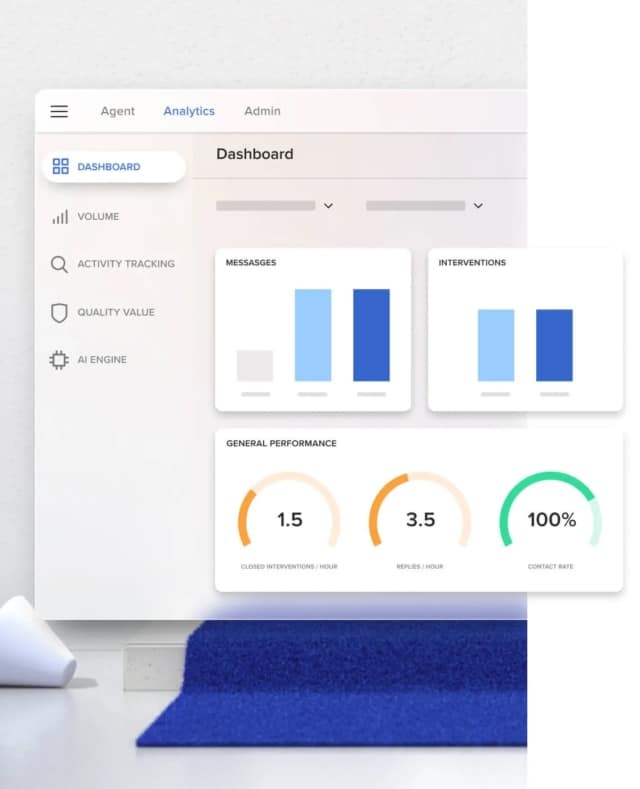Nowadays, most companies use customer relationship management software (CRM software for short). It’s great for keeping on top of the customer journey – from initial contact, to purchase, and through to maintaining a relationship afterwards.
In order to truly excel at this, businesses need to make use of their digital data points. It’s not enough to monitor your website – you need to keep an eye on all your marketing channels and every point of customer interaction.
Luckily, CRM analytics are there to help. Let’s take a look at what exactly CRM analytics mean for your business, and how to make the best use of them.
What is CRM analytics?
CRM analytics includes the tracking, collecting, gathering, and analytical processing of customer data. The purpose of CRM analytics is to gain insights in order to make better-informed business decisions.
CRM analytics can be beneficial to businesses of all sizes. However, the more customers you’re managing, the more important it is to have a comprehensive solution in place. Today, businesses can find a unified platform for customer relationship management and advanced analytics.
Why and where to use CRM analytics
Now we know what CRM analytics involves, it’s time to look at when to use it. Let’s look at some key areas that can benefit:
Customer satisfaction
Nothing is more critical to the lifeblood of a business than the customers. CRM tools will help you nurture better customer relationships. An analytics service will record and track every customer interaction, making it easy to identify problems and create better customer service solutions.
Imagine your business has a pay-monthly subscription service. The sales pipeline is full of good leads, and there’s a high-rate of conversions. You have a customer outreach programme in place to minimise new account cancellations during the first month. However, you notice that the amount of current subscribers isn’t growing at the rate you’d expect.
Implementing a CRM analytics solution might highlight a creeping churn rate among subscribers in the three to six-month range, and help you work out why that is. Whatever the problem, your team will be better able to provide a solution and retain more customers.
Better marketing with segmentation

Customer segmentation is a valuable process for any business. CRM analytics makes identifying customer demographics by age, gender, spending habits, and other qualities, easier.
Businesses that use CRM analytical tools will be able to gather large amounts of data, and draw links between certain traits or qualities. With the right data in hand, marketers and sales staff will be able to tailor strategies to the right customers.
For example, an ecommerce business selling beauty products could easily target their email campaigns. Expensive anti-aging creams and lotion newsletters would go to the older populations with the right spending profiles, while sports supplements would reach the younger populations and those with related purchase history.
CRM analytics can help improve your sales funnel and catch leads with fine-tooth comb. Your marketing campaigns can be targeted to the right audience – meaning potential customers get promotional material that is more relevant to them, and you get greater ROI for your business and greater customer retention.
Efficiency and automation
With a CRM analytics suite doing the hard work of making these connections for you, you’ll be more efficient. Teams can get straight into the hard work of developing campaigns or providing excellent support, without having to explore raw data first.
There’s another bonus too – it can help with your automation. Rather than having to manually trigger certain emails (for instance, review requests), analytics can help you discover the ideal time for certain tasks to occur, and then you can automate them.
Certain behaviours may indicate possible outcomes – perhaps a likelihood of a cancellation, or an increased chance of purchase. Customer data can help you identify these customers and send a relevant email at the right point.
Besides timeliness, automation can also eliminate errors and complete repetitive customer service and administrative tasks with little effort. And staff can manage workflows from a single interface when dealing with customer service tickets, contracts, projects, events, applications and more. This means businesses get more productivity from invested time and money.
Predictive Modeling
CRM solutions use big data to generate accurate predictions for business outcomes. These predictions are a key factor in reducing the overall risk of your business.
One example is better supply chain management through more accurate seasonal predictions. You won’t have to worry about over or under ordering for peak season again. With more accurate predictions, your business will be postured for increases in revenue and company growth.
How CRM analytics Work

CRM analytics starts with automated data mining of touchpoints like sales and lead generation in real-time. All of this data is continuously tracked and collected. The more data the better! Once enough data is collected, a CRM tool can start finding connections, providing insights, and generating reports.
Of course, these insights are no good without people to build on them. Managers, team leaders, and analytics specialists will be able to use this data and the insights gleaned to spot trends, identify problems, and improve services.
Integrations with other platforms can allow your business to track external touchpoints like social media and newsletters. Customer engagement data like mentions and email open-rate will be collected by the platform and categorised automatically. Team members can make use of these third-party metrics in any report generation the business needs.
What data to track with CRM analytics
The customer journey is littered with milestones and events along the way to purchasing. But the customer relationship doesn’t end after a purchase is made.
So what data is actually important to managing your customer relationships? For businesses new to CRM analytics, it can be difficult to even know where to start. To begin with, we can split all customer interactions before and after the sales process.
Before the sale
New prospects
Monitor how well the team is feeding the front of the sales pipeline with potential new customers. You can start by tracking metrics like the number of outbound calls, new leads acquired, and cold emails sent for a defined duration. You will also want to track demographic information for each individual.
New opportunities
You will want to track the first steps from successful prospecting to improve your lead qualification. Have your CRM track initial lead follow-ups like phone calls, proposals sent, and email open rates. Be sure to track responses and customer actions taken too!
Event invitations
Special events like webinars can be a boon to your sales but they can also be resource-heavy. Make sure you are allocating your people, time, and money effectively. Monitor event interest via collecting data on invites, RSVPs, email open rates, and individual attendees. And get more insight by tracking any follow-up correspondence and total sales.
After the sale
Billing and payment
The tracking of payment history can offer foresight into future cancellations of your service. Things like low or late payments should be noted with priority for sales and customer service.
Customer service tickets
No one enjoys having to get in touch with customer service. It’s important to be aware of individual customers with large amounts of service tickets and any details regarding each query. Arm your business with data about call lengths, product issues, and agent performance.
Spotting customers early who are likely to cancel your services gives your team a chance to retain them. It’s also useful for noting repeated problems, so that you can resolve them.
Churn rate

Even with the benefits of CRM analytics, your business will experience customer churn. By tracking data for churn you will be able to spot problems before they grow too big. You can’t completely erase churn. But you can reduce it greatly. Improve churn rate by tracking subscriptions, contract length, renewal, and cancellation rates – and looking at what might be causing it.
Cross-sell and up-sells
Not every interaction post-sale must be about resolving problems and reducing churn. It’s also a chance for sales and marketing to generate revenue through cross-selling and up-selling. Hone in on effective methods by tracking sales rep KPIs, and metrics of each customer interaction. Use the reported data to adjust and tailor campaigns to each customer segment.
Referrals and social media
Engaging customers by providing rewards and incentives for referrals is a great way to build a strong customer base. With CRM systems in place, you can monitor which customers are your best salespeople, and identify why. Make sure to track social media mentions, gather related data and spot trends that your marketing teams can work with.
Challenges
A CRM analytics programme helps your business invest resources with better efficiency and optimize marketing campaigns. It also helps to improve the overall customer experience and improve customer lifetime value. But implementing a CRM analytics system with high functionality does not come without challenges.
That’s a lot of data!
For businesses large or small, tracking every customer touchpoint can only add up to one thing: a lot of data. While a CRM analytics platform can streamline the data gathering process, it’s important to understand what data to gather. With so much to consider, companies can become confused with too much useless or irrelevant information. It is important for companies to understand how CRM analytics works before planning it’s implementation.
Privacy
Anytime a business collects customer data, privacy is an issue. It is the responsibility of each business to ensure they are using CRM software that is compliant with local laws (like GDPR).
Databases are under the threat of attack – whether stored locally, or on private or public clouds. Any business using CRM analytics needs to have strong security measures in place to protect the data they’re using – this means IT solutions like anti-virus protection and secure firewalls on all company devices.
Training and education
Learning how to understand and apply CRM analytics is a specific skill, so teams will need training. There’s two aspects to this – first, learning how to use the platform, and second, learning what CRM data is pertinent and which metrics provide insight. For some businesses, the time and other resources dedicated to laying down the new framework can be difficult to overcome.
How to use RingCentral for CRM analytics
RingCentral’s omnichannel cloud contact centre helps your team give great customer service. From one workspace, agents can handle inbound and outbound calls as well as any channel of online communication. But how can this help with CRM analytics?
RingCentral integrates with your CRM software like Salesforce, Hubspot and Zoho. This means relevant data about how your outbound and inbound communication is doing can be gathered and analysed.
With this, you can improve your digital customer engagement. Not only can you make use of CRM analytics, but RingCentral has its own data analysis capabilities. You can track metrics like call volume, activity and quality.
With RingCentral and integrated CRM software, you can turn that raw data into greater agent productivity, more effective marketing campaigns, and better customer service. Get in touch with today to discuss options that fit your business needs.
Originally published Jun 23, 2021



